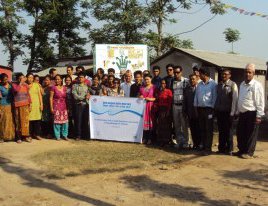
Tirth Maya Lopchan, a resident of Bagbazar Chowk of Saradanagar of Chitwan district, has seen a completely new cycle of life from a dirty place of a few years ago to a hygienic and clean locality of the present day.
“Our locality was regarded as the dirtiest place till 2009. After the implementation of SWASHTHA, a project by Practical Action in 2009, the state of sanitation has changed drastically. We are proud about that,” said Tirtha Maya Lopchan, sharing her experiences in the backdrop of a sidewalk program during the SACOSAN-V in Kathmandu. “Out of 80 houses, only eight houses have toilets and there was rampant open defecation. Our community has complete sanitation now, with almost all houses having the toilet.”
At a time when the high level government delegations were discussing about the way to improve sanitation, a group led by Lopchan was showing how sustainable sanitation was possible in poor communities.
“Along with bringing sanitation, SWASHTHA also changed the health of the people. Before implementation of the project, there was no day when a children or an elderly did not visit the hospital or medical store to treat typhoid, diarrhea and the like disease. Now, water-borne diseases are rare in the community,” said Lopchan.
“Along with sanitation, we also use different methods to purify water. We didn’t know the importance of sanitation and healthy behavior before.”
Along with Nepalese government officials, NGO activists and delegates from South Asia listened the experiences of Lopchan. From a state with virtually no toilets for defecation and wells for safe drinking water and sanitation, the situation has changed significantly in the community and this set up a unique example in the Nepalese context.
"Our program is related to urban water, sanitation and waste," said Shrish Singh, head of program, urban with sanitation, Practical Action. “Every single household in the community now has toilet, safe drinking water, improved sanitation conditions, better hygiene practice, proper waste management, and better kitchen management. Thus, the community has been declared as a healthy community.”
Under the co-funding support of European Union’s non-state actors in development program, UN-Habitat’s Water for Asian Cities program and the ISLE of Man government, the project was implemented by Practical Action in partnership with MuAN and ENPHO as non-state actors and the respective municipalities and concerned VDCs as local sate actors.
“This is a small project to show how we can achieve complete sanitation and make the community healthy,” said Hari Krishna Poudel, head of Chitwan District Urban Development Division, which is now expanding the program in other localities with the government’s resources.
“The project implemented from 2009-2012 focused on Bharatpur, Gulariya, and Tikapur Municipalities of Nepal with the main objective of improving the health and wellbeing of the urban and peri-urban settlements. The project also worked on the few urban environmental problems of neighboring municipalities and small towns like Rantanagar, Ramgram, Siddharthnagar, Sunwal, Bardghat and Kawasoti,” said Achyut Luitel, country director Practical Action Nepal Office.
Experts in SACOSAN-V argued that water and sanitation related diseases are amongst the leading cause of disease and death in the South Asia Region including Nepal. According to a study, each year 14,700 people die because of unsafe water, lack of sanitation and unsafe hygiene practices. This affects the young children more severely. The studies have shown that 12700 children under the age of five die due to poor hygiene and sanitation and acute respiratory infection.
In Nepal, Water, Sanitation and Hygiene (WASH) attributes to 10 percent of deaths each year. A lot of focus has been given to increase access to water and sanitation and make people adopt hygienic practices and achieve Open Defecation Free (ODF) status. However, not all are able to achieve the expected results. Here comes the Practical Action’s integrated approach to WASH, instead of a sector specific approach in order to improve environmental health conditions of urban poor communities. “We adopt three participatory approaches, household centered environmental sanitation, school led total sanitation and community led total sanitation for sustainable promotion of water sanitation and IAP reducing facilities,” said Singh. “Our SWASHTHA includes safe water, better sanitation, personal hygiene, kitchen management and solid waste management.”
After the implementation of the project, eighty household of Baghbazar tole in Sharadanagar in Chitwan District set an example almost unique in Nepal and the region, with every single household consuming safe water, using improved sanitation facilities, practicing safe hygienic behavior, enjoying improved kitchen and managing solid waste properly. This is what, Lopchan claimed in the gathering, is a healthy community of Nepal.
- TANAHU HYDROPOWER PROEJCT: A Significant Achievement
- Apr 15, 2024
- AMBASSADOR HANAN GODAR: Sharing Pain With A Nepali Family
- Mar 30, 2024
- VISIT OF KfW AND EIB TO NEPAL : Mission Matters
- Mar 25, 2024
- NEPAL BRITAIN SOCIETY: Pratima Pande's Leadership
- Mar 24, 2024
- NEPAL ARMY DAY: Time To Recall Glory
- Mar 15, 2024
















